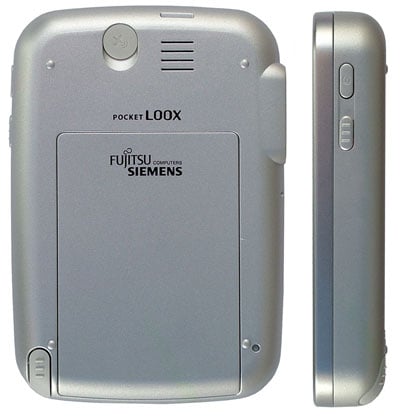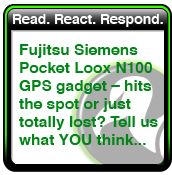This article is more than 1 year old
Fujitsu Siemens Pocket Loox N100 handheld GPS
A serious contender for the established players?
On the top of the N100 you'll find a two-section extending stylus which has a big enough girth to be comfortable in the hand, as well as the main power button and the hold switch, which deactivates the touch-sensitive screen.

On the subject of the screen, what you get is a 2.8in, 240 x 320 (QVGA) TFT screen, which is a pleasure to use. Performance in bright sunlight was excellent, and squeezing a QVGA resolution into such a relatively small screen meant text was pin-sharp. Both brightness and contrast were extremely good and this more than compensates for its small size. All of the important route-related data is large and clear enough to be seen at a glance, and while it can be awkward to read the smaller bits of information quickly, you should pull over before you access anything other than navigation instructions.
The back of the N100 gives access to the removable 3.7V, 1100mAh battery which charges up in around four hours. Battery stamina will obviously depend on what exactly you're doing: navigating will presumably put more demands on the power pack than, for example, music playback, during which you can switch off the screen backlight should you wish.
 Flanking the battery is a rubber plug which protects the connector for the optional external antenna and alongside this is the worryingly ineffective-looking speaker grill. As it happens, I needn't have worried as spoken directions are as loud as any GPS unit I've tested thus far, including the larger ones. The N100 produced minimal distortion even at full volume, which is significantly loud. The rear of the device is also where you'll find the recessed soft reset button, which I've not as yet needed to resort to.
Flanking the battery is a rubber plug which protects the connector for the optional external antenna and alongside this is the worryingly ineffective-looking speaker grill. As it happens, I needn't have worried as spoken directions are as loud as any GPS unit I've tested thus far, including the larger ones. The N100 produced minimal distortion even at full volume, which is significantly loud. The rear of the device is also where you'll find the recessed soft reset button, which I've not as yet needed to resort to.
At the heart of the N100 is a Samsung 300MHz CPU running Windows CE 5.0. A frequency of 300MHz may seem relatively tame in comparison to some of the more expensive sat nav units on the market, but it never felt particularly underpowered. Calculation and recalculation times are all relatively swift and the clever use of animated menus helps disguise any minor lag that may be present. GPS functions are handled by the SiRFStar III chipset, which guarantees improved signal sensitivity and ensures a speedy time-to-first-fix, plus support for WAAS and EGNOS which in turn improve positional accuracy.
